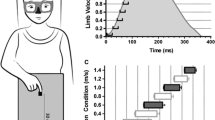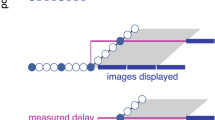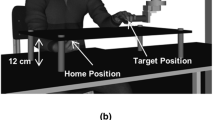Abstract
We determined whether uncertainty about the location of one’s hand in virtual environments limits the efficacy of online control processes. In the Non-aligned and Aligned conditions, the participant’s hand was represented by a cursor on a vertical or horizontal display, respectively. In the Natural condition, participants saw their hand. During an acquisition phase, visual feedback was either permitted or not during movement execution. To test the hypothesis (Norris et al. 2001) that reliance on visual feedback increases as the task becomes less natural (Natural < Aligned < Non-aligned), following acquisition, participants performed a transfer phase without visual feedback. During acquisition in both visual feedback conditions, movement endpoint variability increased as the task became less natural. This suggests that the orientation of the display and the representation of one’s hand by a cursor introduced uncertainty about its location, which limits the efficacy of online control processes. In contradiction with the hypothesis of Norris et al. (2001), withdrawing visual feedback in transfer had a larger deleterious effect on movement accuracy as the task became less natural. This suggests that the CNS increases the weight attributed to the input that can be processed without first having to be transformed.




Similar content being viewed by others
Notes
In transfer, within-participant variability at key kinematic markers showed no difference between Feedback conditions. As in acquisition, variability increased up to peak deceleration, although more importantly for the Non-aligned condition than for the other two conditions. There was a significant decrease in variability between peak deceleration and movement endpoint. This decrease was significantly larger in the Natural than in the Aligned condition and in the Aligned than in the Non-Aligned condition.
This position might appear difficult to reconcile with recent observations reported by van Beers et al. (1999), who asked participants to match the position of their right index finger with their left index finger. In one condition, the participants could see their entire right arm, whereas in a second condition, they could only see the tip of their right index finger. The results did not reveal any significant difference in position matching variability between the two conditions, which contradicts our hypothesis. However, in that study, the position of the right index finger was also “known” through proprioceptive information transiting via the corpus callosum. Therefore, when there is no direct interhemispheric transfer of information concerning the position of one’s finger, it remains possible that seeing one’s entire arm rather than only one’s finger tip prior to movement initiation increases the reliability of the initial stylus position.
References
Bagesteiro LB, Sarlegna FR, Sainburg RL (2006) Differential influence of vision and proprioception on control of movement distance. Exp Brain Res 171(3):358–370
Bédard P, Proteau L (2005) Movement planning of video and of manual aiming movements. Spat Vis 18(3):275–296
Bo J, Contreras-Vidal JL, Kagerer FA, Clark JE (2006) Effects of increased complexity of visuo-motor transformations on children’s arm movements. Hum Mov Sci 25(4–5):553–567
Bourdin C, Bringoux L, Gauthier GM, Vercher JL (2006) Vision of the hand prior to movement onset allows full motor adaptation to a multi-force environment. Brain Res Bull 71(1–3):101–110
Carey D, Otto-de Haart E (2001) Hemispatial differences in visually guided aiming are neither hemispatial nor visual. Neuropsychologia 39(9):885–894
Clower DM, Boussaoud D (2000) Selective use of perceptual recalibration versus visuomotor skill acquisition. J Neurophysiol 84(5):2703–2708
Desmurget M, Grafton ST (2003) Feedback or feedforward control: end of a dichotomy. In: Johnson-Frey SH (ed) Taking action: cognitive neuroscience perspectives on intentional acts. MIT press, Cambridge, pp 289–338
Desmurget M, Rossetti Y, Prablanc C, Stelmach GE, Jeannerod M (1995) Representation of hand position prior to movement and motor variability. Can J Physiol Pharmacol 73(2):262–272
Desmurget M, Turner RS, Prablanc C, Russo GS, Alexander GE, Grafton ST (2005) Updating target location at the end of an orienting saccade affects the characteristics of simple point-to-point movements. J Exp Psychol Hum Percept Perform 31(6):1510–1536
Fisk JD, Goodale MA (1985) The organization of eye and limb movements during unrestricted reaching to targets in contralateral and ipsilateral visual space. Exp Brain Res 60(1):159–178
Fitts PM (1954) The information capacity of the human motor system in controlling the amplitude of movement. J Exp Psychol 47(6):381–391
Ghez C, Gordon J, Ghilardi MF (1995) Impairments of reaching movements in patients without proprioception. Ii. Effects of visual information on accuracy. J Neurophysiol 73(1):361–372
Ghilardi MF, Gordon J, Ghez C (1995) Learning a visuomotor transformation in a local area of work space produces directional biases in other areas. J Neurophysiol 73(6):2535–2539
Goodbody SJ, Wolpert DM (1999) The effect of visuomotor displacements on arm movement paths. Exp Brain Res 127(2):213–223
Gordon J, Ghez C (1987) Trajectory control in targeted force impulses. Iii. Compensatory adjustments for initial errors. Exp Brain Res 67(2):253–269
Gordon J, Ghilardi MF, Cooper SE, Ghez C (1994) Accuracy of planar reaching movements. Ii. Systematic extent errors resulting from inertial anisotropy. Exp Brain Res 99(1):112–130
Graham E, MacKenzie C (1996) Physical versus virtual pointing. In: Conference on human factors in computing systems: Proceedings of the SIGCHI conference on human factors in computing systems: common ground, Vancouver, British Columbia, Canada, ACM, pp 292–299
Graziano MS, Cooke DF, Taylor CS (2000) Coding the location of the arm by sight. Science 290(5497):1782–1786
Grierson LE, Gonzalez C, Elliott D (2009) Kinematic analysis of early online control of goal-directed reaches: a novel movement perturbation study. Mot Control 13(3):280–296
Harris CM, Wolpert DM (1998) Signal-dependent noise determines motor planning. Nature 394(6695):780–784
Heath M (2005) Role of limb and target vision in the online control of memory-guided reaches. Mot Control 9(3):281–311
Heath M, Westwood DA, Binsted G (2004) The control of memory-guided reaching movements in peripersonal space. Mot Control 8(1):76–106
Khan MA, Elliott D, Coull J, Chua R, Lyons J (2002) Optimal control strategies under different feedback schedules: kinematic evidence. J Motor Behav 34(1):45–57
Khan MA, Lawrence GP, Fourkas A, Franks IM, Elliott D, Pembroke S (2003) Online versus offline processing of visual feedback in the control of movement amplitude. Acta Psychol 113(1):83–97
Khan MA, Franks IM, Elliott D, Lawrence GP, Chua R, Bernier PM, Hansen S, Weeks DJ (2006) Inferring online and offline processing of visual feedback in target-directed movements from kinematic data. Neurosci Biobehav Rev 30(8):1106–1121
Lateiner JE, Sainburg RL (2003) Differential contributions of vision and proprioception to movement accuracy. Exp Brain Res 151(4):446–454
Lhuisset L, Proteau L (2002) Developmental aspects of the control of manual aiming movements in aligned and non-aligned visual displays. Exp Brain Res 146(3):293–306
Lhuisset L, Proteau L (2004) Planning and control of straight-ahead and angled planar movements in adults and young children. Can J Exp Psychol 58(4):245–258
Mackrous I, Proteau L (2007) Specificity of practice results from differences in movement planning strategies. Exp Brain Res 183(2):181–193
Mandryk R, MacKenzie C (1999) Superimposing display space on workspace in the context of endoscopic surgery. In: Conference on human factors in computing systems, Pittsburgh, Pennsylvania, ACM, pp 284–285
Messier J, Kalaska JF (1997) Differential effect of task conditions on errors of direction and extent of reaching movements. Exp Brain Res 115(3):469–478
Messier J, Kalaska JF (1999) Comparison of variability of initial kinematics and endpoints of reaching movements. Exp Brain Res 125(2):139–152
Meyer DE, Abrams RA, Kornblum S, Wright CE, Smith JE (1988) Optimality in human motor performance: ideal control of rapid aimed movements. Psychol Rev 95(3):340–370
Norris SA, Greger BE, Martin TA, Thach WT (2001) Prism adaptation of reaching is dependent on the type of visual feedback of hand and target position. Brain Res 905(1–2):207–219
Proteau L (1992) On the specificity of learning and the role of visual information for movement control. In: Elliott D, Proteau L (eds) Vision and motor control, vol 85. North Holland, Amsterdam, pp 67–103
Proteau L (2005) Visual afferent information dominates other sources of afferent information during mixed practice of a video-aiming task. Exp Brain Res 161(4):441–456
Proteau L, Isabelle G (2002) On the role of visual afferent information for the control of aiming movements toward targets of different sizes. J Motor Behav 34(4):367–384
Proteau L, Masson G (1997) Visual perception modifies goal-directed movement control: supporting evidence from a visual perturbation paradigm. Q J Exp Psychol A 50(4):726–741
Robin C, Toussaint L, Blandin Y, Proteau L (2005) Specificity of learning in a video-aiming task: modifying the salience of dynamic visual cues. J Motor Behav 37(5):367–376
Rossetti Y, Stelmach G, Desmurget M, Prablanc C, Jeannerod M (1994) The effect of viewing the static hand prior to movement onset on pointing kinematics and variability. Exp Brain Res 101(2):323–330
Rossetti Y, Desmurget M, Prablanc C (1995) Vectorial coding of movement: vision, proprioception, or both? J Neurophysiol 74(1):457–463
Sainburg RL, Lateiner JE, Latash ML, Bagesteiro LB (2003) Effects of altering initial position on movement direction and extent. J Neurophysiol 89(1):401–415
Schmidt RA, Lee TD (2005) Motor control and learning: a behavioral emphasis, 4th edn. Human Kinetics Champaign, IL
Schmidt RA, Zelaznik HZ, Hawkins B, Frank JS, Quinn JT (1979) Motor-output variability: a theory for the accuracy of rapid motor acts. Psychol Rev 47(5):415–451
Sober SJ, Sabes PN (2005) Flexible strategies for sensory integration during motor planning. Nat Neurosci 8(4):490–497
Soucy MC, Proteau L (2001) Development of multiple movement representations with practice: specificity versus flexibility. J Motor Behav 33(3):243–254
Tremblay L, Proteau L (1998) Specificity of practice: the case of power lifting. Res Q Exercise Sport 69(3):284–289
van Beers RJ, Sittig AC, van der Gon JJD (1999) Localization of a seen finger is based exclusively on proprioception and on vision of the finger. Exp Brain Res 125(1):43–49
van Beers RJ, Haggard P, Wolpert DM (2004) The role of execution noise in movement variability. J Neurophysiol 91(2):1050–1063
Veilleux LN, Proteau L (2010) Factors influencing online control of video-aiming movements performed without vision of the cursor. Psychol Res 74(2):182–195
Vindras P, Viviani P (1998) Frames of reference and control parameters in visuomanual pointing. J Exp Psychol Hum Percept Perform 24(2):569–591
Acknowledgment
This work was supported by a Discovery grant (L. P.) provided by the Natural Sciences and Engineering Research Council of Canada.
Author information
Authors and Affiliations
Corresponding author
Rights and permissions
About this article
Cite this article
Veilleux, LN., Proteau, L. Suboptimal online control of aiming movements in virtual contexts. Exp Brain Res 208, 345–358 (2011). https://doi.org/10.1007/s00221-010-2487-9
Received:
Accepted:
Published:
Issue Date:
DOI: https://doi.org/10.1007/s00221-010-2487-9




